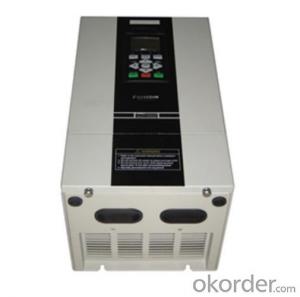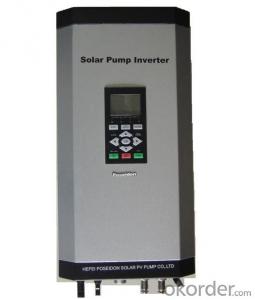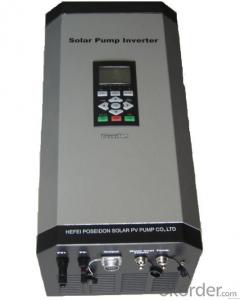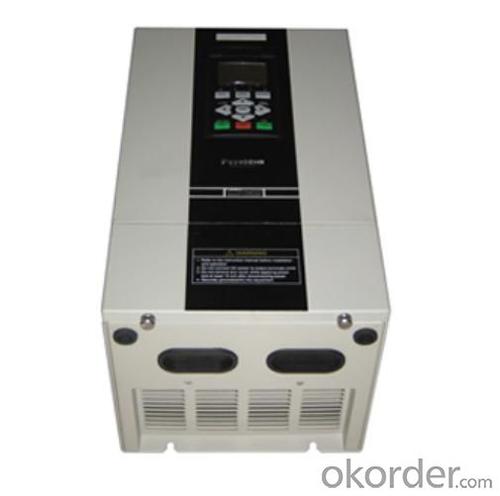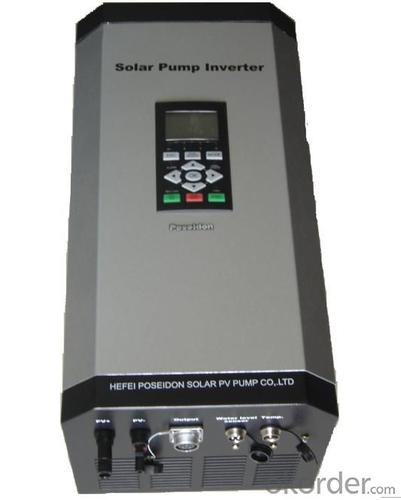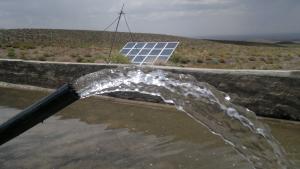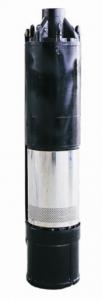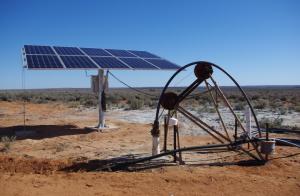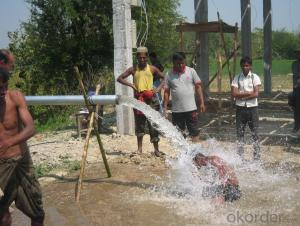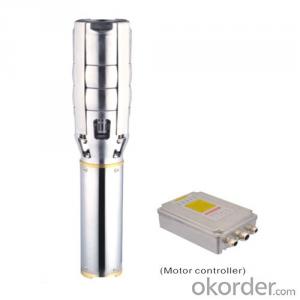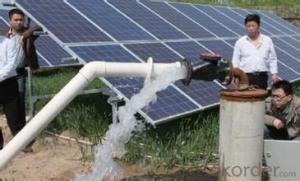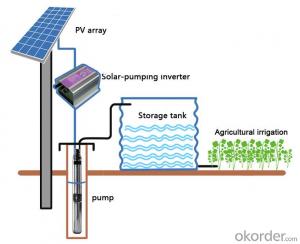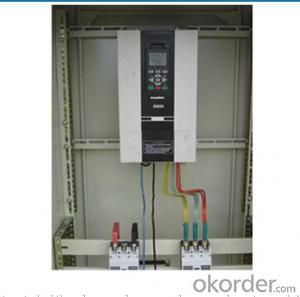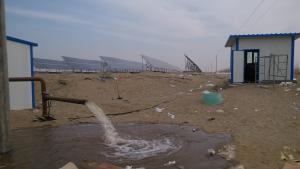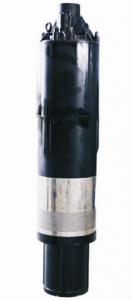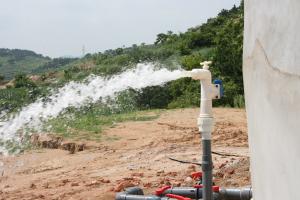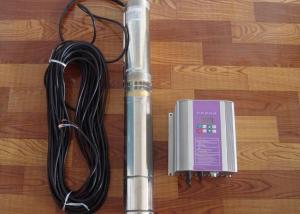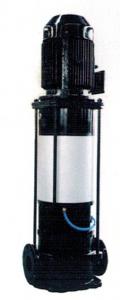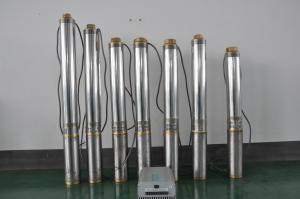Solar Pump Inverter FCPM22KH - Solar Pump Supplier
- Loading Port:
- China Main Port
- Payment Terms:
- TT OR LC
- Min Order Qty:
- -
- Supply Capability:
- -
OKorder Service Pledge
Quality Product, Order Online Tracking, Timely Delivery
OKorder Financial Service
Credit Rating, Credit Services, Credit Purchasing
You Might Also Like
Solar pump inverter FCPM22KH Product Description:
Solar water pumping system is constructed with solar panel array,solar pump inverter and AC water pump, DC current produced from solar panel will be delivered to solar pump inverter,and it will convert it into AC current to drive water pump,and will automatically regulate output frequency according to sun radiance intensity,maximally realize MPPT tracking function.
Features
Adopting the proposed dynamic VI maximum power point tracking (MPPT) control method, with fast response, and reliable operation, achieves efficiency of 99%.
Designed with variable frequency driver, greatly improves efficiency
Extremely high efficiency
Digital mode control, with automatic operation and manual operation mode options
Complete protection functions
Adopts intelligent IPM module, with high reliability
LCD display and operation panel, in real time presents operating data
Optional for water level measurement and control circuit
Applicable for general ACC pumps, like centrifugal pump, piston pump etc.
Independent intellectual property; Highly effective, the redundant reliability, exempts the maintenance and the long life.
The pumps are soft started, fully protected.
No batteries are used. So better Sunlight, more water.
Datasheet.
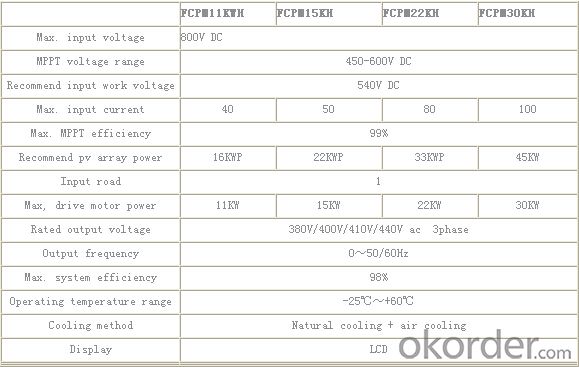
- Q: Can a solar pump be used for wastewater recycling?
- Yes, a solar pump can be used for wastewater recycling. Solar pumps are an environmentally friendly and cost-effective solution for pumping water, including wastewater, using solar energy. By utilizing solar power, these pumps can help in the process of recycling wastewater for various purposes such as irrigation, industrial uses, or even for non-potable water needs.
- Q: What is the warranty period for a solar pump?
- The warranty period for a solar pump varies depending on the manufacturer and specific model. It can range from 1 year to 10 years, with some manufacturers offering extended warranties as well. It is advisable to check with the manufacturer or supplier for the specific warranty period of the solar pump in question.
- Q: Can solar pumps be used in areas with high salt or mineral content in the water?
- Yes, solar pumps can be used in areas with high salt or mineral content in the water. However, it is important to choose solar pumps that are specifically designed to handle such conditions. These pumps are typically constructed with corrosion-resistant materials and may have additional features like built-in filters or desalination capabilities to prevent damage and ensure efficient water pumping.
- Q: How does the cost of a solar pump compare to a diesel or electric pump?
- The cost of a solar pump compared to a diesel or electric pump can vary depending on several factors. In terms of upfront costs, a solar pump generally has a higher initial investment compared to a diesel or electric pump. This is because a solar pump requires the installation of solar panels, inverters, and batteries to harness and store solar energy. These additional components can increase the overall cost of the system. However, when considering the long-term operational costs, a solar pump is significantly more cost-effective. Solar energy is free and abundant, which means there are no fuel costs associated with running a solar pump. On the other hand, diesel pumps require regular fuel refills, and electric pumps are connected to the grid, which means ongoing electricity bills. Moreover, solar pumps have lower maintenance costs compared to diesel or electric pumps. Diesel pumps require frequent maintenance to ensure proper functioning, such as oil changes, filter replacements, and regular engine maintenance. Electric pumps may also require maintenance and repairs due to electrical faults or grid outages. In contrast, solar pumps have relatively fewer moving parts, making them more reliable and requiring less maintenance. Additionally, solar pumps are environmentally friendly as they produce zero greenhouse gas emissions during operation, whereas diesel pumps contribute to air pollution and carbon emissions. Electric pumps, although cleaner, still rely on electricity generated from various sources, some of which may involve carbon-intensive methods. It is important to note that the cost comparison between these types of pumps may vary depending on factors such as the size of the system, location, local energy prices, and the availability of sunlight. In some cases, government incentives or subsidies for renewable energy technologies may also affect the cost comparison. Overall, while the upfront cost of a solar pump may be higher, its lower operational and maintenance costs, as well as its environmental benefits, make it a more cost-effective and sustainable choice in the long run compared to diesel or electric pumps.
- Q: Are there any limitations to using a solar pump?
- Yes, there are some limitations to using a solar pump. One limitation is that solar pumps are dependent on sunlight, so they may not work efficiently or at all on cloudy or rainy days. Another limitation is that the amount of water pumped by a solar pump is directly related to the intensity of sunlight, so it may vary throughout the day and throughout the seasons. Additionally, solar pumps can be more expensive to install compared to traditional pumps, although they can save money in the long run due to lower operational costs.
- Q: What is the minimum solar panel capacity required for a solar pump?
- The minimum solar panel capacity required for a solar pump depends on various factors such as the power requirements of the pump, the amount of sunlight available in the location, and the desired performance of the pump. To determine the minimum solar panel capacity, you need to consider the power consumption of the pump, which is typically measured in watts (W) or kilowatts (kW). This information can usually be found in the pump's specifications or user manual. Once you have the power consumption of the pump, you can calculate the minimum solar panel capacity needed by considering the average daily sunlight hours in your location. Solar panels have a rating called the peak power output, which is the maximum power they can generate under ideal conditions. This rating is typically given in watts (W) or kilowatts (kW). To estimate the minimum solar panel capacity, divide the total power consumption of the pump by the average daily sunlight hours. This will give you the minimum solar panel capacity required to meet the power demands of the pump. It's important to note that this calculation provides a rough estimate, and it's always recommended to consult with a solar professional or supplier who can assess your specific needs and provide accurate recommendations based on factors such as pump efficiency, battery storage requirements, and any additional power needs.
- Q: How does a solar pump help in reducing the risk of electrical accidents?
- A solar pump helps in reducing the risk of electrical accidents by eliminating the need for electrical connections and power sources, as it operates solely on solar energy. This eliminates the risk of electrical shock, short circuits, and other electrical accidents that can occur when using traditional pumps powered by electricity.
- Q: Are there any government incentives or subsidies for using solar pumps?
- Yes, there are government incentives and subsidies available for using solar pumps. Many governments around the world recognize the importance of promoting renewable energy sources like solar power and have implemented various programs and incentives to encourage the adoption of solar pumps. One common form of incentive is the provision of tax credits or rebates for individuals or businesses that invest in solar pump systems. These credits or rebates can significantly reduce the upfront costs of purchasing and installing solar pumps, making them more affordable and attractive to consumers. Some governments also offer grants or subsidies specifically targeted at promoting the use of solar pumps in certain sectors or regions. These grants can help offset the costs of purchasing and installing solar pump systems, making them more accessible to farmers, rural communities, or areas with limited access to electricity. Additionally, some governments have implemented net metering policies, which allow individuals or businesses with solar pumps to sell excess electricity generated back to the grid. This can result in significant savings on electricity bills or even generate additional income for the system owner. It is important to note that the availability and specifics of these incentives and subsidies can vary from country to country and even within different regions of the same country. Therefore, it is advisable to check with the local government or relevant authorities to get accurate and up-to-date information on the specific incentives and subsidies available for using solar pumps in a particular location.
- Q: Are there any safety considerations for solar pump installations?
- Yes, there are several safety considerations for solar pump installations. Firstly, proper installation and grounding of the solar panels and electrical components are crucial to prevent electric shock hazards. It is important to follow the manufacturer's instructions and local electrical codes during installation. Additionally, regular maintenance and inspection of the system are necessary to identify any potential issues or malfunctions that could pose safety risks. It is also advisable to have a disconnect switch or breaker in place to shut off power during maintenance or emergencies. Lastly, precautions should be taken to protect the pump and its components from extreme weather conditions, such as lightning strikes or flooding, which could affect the system's performance and safety.
- Q: How does the performance of a solar pump vary with different sunlight intensities?
- The performance of a solar pump varies with different sunlight intensities. Solar pumps are designed to operate using solar energy, which means they are directly affected by the amount of sunlight available. When sunlight intensity is high, meaning there is abundant sunshine, the solar pump will have a higher performance. This is because the solar panels will receive more sunlight and produce more electricity, which in turn powers the pump to operate at its maximum capacity. The higher the sunlight intensity, the more energy is generated and the more efficiently the pump can function. On the other hand, when sunlight intensity is low, such as during cloudy or overcast days, the performance of the solar pump will be reduced. This is because there is less sunlight available for the solar panels to convert into electricity. As a result, the pump may operate at a slower speed or even stop working altogether if the sunlight intensity is too low. It is important to note that the performance of a solar pump is not solely dependent on sunlight intensity. Other factors like the efficiency of the solar panels, the size of the pump, and the capacity of the battery (if present) also play a role in determining its overall performance. However, sunlight intensity remains a critical factor as it directly affects the amount of energy that can be harnessed from the sun, thereby impacting the efficiency and output of the solar pump.
Send your message to us
Solar Pump Inverter FCPM22KH - Solar Pump Supplier
- Loading Port:
- China Main Port
- Payment Terms:
- TT OR LC
- Min Order Qty:
- -
- Supply Capability:
- -
OKorder Service Pledge
Quality Product, Order Online Tracking, Timely Delivery
OKorder Financial Service
Credit Rating, Credit Services, Credit Purchasing
Similar products
Hot products
Hot Searches
Related keywords
